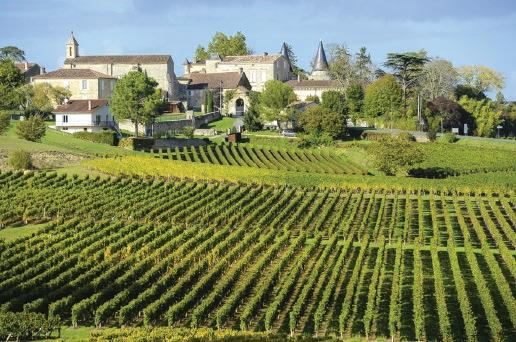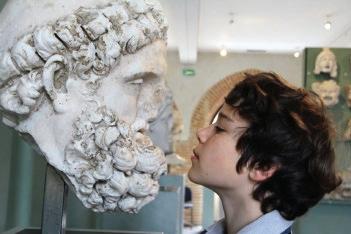
9 minute read
Tours and Visits
Let’s Go!
Tours & Visits
Advertisement
Whether you take a bus, boat, bike, train, micro-light, hot air balloon, a chauffeured vehicle, a horse or simply walk, guided tours are an ideal way to find out the secrets or, at least, the little known facts that lie behind the historical monuments and treasures in our region. Here’s a snapshot of ideas.

GIRONDE


GIRONDE
This iconic image is no camera trick, it’s a real reflection from the Miroir d’Eau, the world’s largest reflecting pool. Located in front of Place de la Bourse in Bordeaux and built in 2006, it is made of granite slabs covered by 2cm of water and creates a mist every 15 minutes which is fabulously cooling on a hot summer’s day. Did you know that there is so much more to the Saint-André de Bordeaux Cathedral than architecture, religious artefacts and stained glass windows? It is also home to the Marcadé collection of some 42 illuminated sculptures, paintings and objects. Fresh, sea air, oyster farms, 19th-century houses, views over the stunning Bay and the Cap-Ferret Peninsula are waiting for you in and around Arcachon where you can discover the Belle Epoque in its historical quarter. Interested in wines? Gironde is the land of over 8,500 vineyards and there are countless châteaux and bars offering wine-tastings as well as museums and, of course, La Cité du Vin and its ever-changing exhibitions. No itinerary, whether food, wine, architecture or historically related, would be worth its salt if it didn’t include the UNESCO World Heritage sites of Saint-Emilion and its medieval, narrow streets, and the 17th-century fortified Citadelle de Blaye.


La Cité du Vin
The Miroir d’Eau

DORDOGNE
LOT ET GARONNE


DORDOGNE
You can’t quite rub shoulders (or noses) with Cyrano de Bergerac as he is literally on a pedestal but, unlike him, you can enjoy a visit and leisurely stroll around Bergerac with its pretty, half-timbered architecture, tobacco museum and the beautiful Cloîture des Récollets. Or why not learn the fascinating facts about Périgueux during the Renaissance period, and take your pick of fortified castles and beautiful villages such as Domme, Beynac and La RoqueGageac with their charming streets and breathtaking landscapes? Love water? You could join a canoe, barge or boat tour and follow the river Dordogne, marvelling at the buildings and structures that defy gravity on the cliffs above. Feeling warm? Take a break from the sunshine and go underground for a look at incredible, palaeolithic art in the Lascaux Caves, the Grotte de Rouffignac or the caves of Font-de-Gaume. There are some 1001 châteaux in Dordogne and many offer visits to the property and grounds as well as the cellars for an informative wine-tasting and an explanation of the workings of a vineyard. You could also visit a sturgeon farm, the imaginative Les Jardins Suspendus de Marqueyssac, learn about truffles or, perhaps, enjoy a gourmet lunch as part of a tour of local gourmand delicacies and their producers.

Take your pick of cycling tours
Prehistoric art at the Lascaux Caves
LOT ET GARONNE
As well as home to the Musée des Beaux Arts, Agen, the Préfecture, is particularly famous for Pruneaux d’Agen, so named because it was the port from where they were shipped. Prune factories and museums can be found throughout the region demonstrating the production and drying process. Gourmands can also savour trips to duck and geese farms, honey producers, chocolatiers, hazelnut growers and the many vineyards in and around Duras and Buzet-sur-Baïze. Go back in time to pre-historic days at the caves of Fontirou and La Grotte de Lastournelle, or bring yourself more up to date with the impressive Gallo-Roman remains at Villascopia and the medieval history of towns like Monflanquin and Penne d’Agenais. Visit churches and cathedrals as well as fortified castles such as the Château de Bonaguil and historical monuments such as the Château-Musée Henri IV at Nérac which was home, for a while, to the future King Henry IV. Don’t miss the 12th-century château at Duras or the many wonderful bastides such as Villeréal, Montpezat and Puymirol. You can also find out how and why waterlilies so inspired Monet at the Jardins des Nénuphars Latour-Marliac, and take a relaxing boat or cycle tour along the rivers and, of course, the famous Canal Latérale (Canal des Deux Mers).
Cruising on the Canal Latérale high above Agen


La Rogue-Gageac Grottes de Fontirou Don’t miss Goya at Musée des Beaux Arts


LOT

LOT
The 150 million years old Plage aux Ptérosaures at Crayssac is a must see. Discovered in the late 1980s, palaeontologists have since revealed “Jurassic” footprints left by dinosaurs, crocodilian pterosaurs, turtles and crustaceans. Such is the diverse charm of Cahors that, along with walking and cycling tours, you can opt for Le Petit Train or a river cruise for a different perspective. Scenic Rocamadour features a visit to the sanctuary and its chapels via the pilgrim’s staircase, a climb of 216 steps to see the Black Virgin, the legendary Durandal Sword and the Sarcophagus of St Amadour. SItting on rock 100m above the river Lot, the beautiful, medieval Saint Cirq Lapopie boasts 13 historic monuments and the Parcours d’Art Contemporain (contemporary art trail). Gourmet tours feature black truffles, foie gras, Rocamadour cheese, Quercy lamb, melons, the wonders of saffron and, of course, the Malbec grape and its black wines. In fact, there are over 65 individual wine estates to visit with many offering tours of their vines and cellars. The magical Grottes de Lacave, the wonders of The Pech Merle Cave and a boat ride through the Padirac Chasm would also be highlights on any itinerary.


The Pech Merle Cave

Beautiful Rocamadour Saint Cirq Lapopie
and wildlife tours to highlight the best that Gers has to offer. The Abbaye Cistercienne de Flaran, for instance, combines 12th-18th century architecture with the Simonow art collection, majestic gardens and a petting zoo! A guided visit at Cathédrale Sainte-Marie in Auch, a city worthy of a visit in itself, highlights its Gothic flamboyance and Renaissance style whilst, over at the Musée du Trésor de la Cathédrale, there are over 230 sacred objects to be discovered. Route Européene d’Artagnan will eventually trace the real-life musketeer’s journey from his birthplace to Maastricht in Holland, where he died in 1673. Starting in Lupiac, your tour by horse, bike or on foot can be arranged to suit you but be sure to visit the d’Artagnan Museum and stop by to see his lifelike statue in the town square whilst you are there.
Art at Abbaye Cistercienne de Flaran
GERS
GERS
There’s no shortage of vineyard tours and tastings, especially for the department’s famous Armagnac and, in Moncluc, visit the château and learn the history of its exclusive orange-flavoured Armagnac liqueur, Pousse Rapière. For a true gastronomic experience, take in the saffron fields and learn about Gers gastronomy including Porc Noir, confit and the delicious La Croustadière. Churches and museums join nature
Armagnac in the making



TARN ET GARONNE

TARN ET GARONNE
Gourmet tours includes visits to local artisans as they produce honey, charcuterie, duck and geese conserves, goat’s cheese, and, of course, vineyards and their wines which highlight the earthiness of the rich soil and are served with traditional dishes such as cassoulet. Situated at the confluence of the rivers Garonne and Tarn at the Canal de Garonne it is no surprise that boat excursions are likely to feature on any visit to the area. On land, you will be spoilt for choice when it comes to which towns and villages you might like to visit. Some of the oldest include fortified Bruniquel with its fabulous château(x), 13th-century Lauzerte, and SaintAntonin-Noble-Val with its many historical monuments. Rivalling “The Pink City” with its red bricks, Montauban was birthplace to Jean Ingres, the celebrated painter whose works can be seen in the Musée Ingres. The medieval Saint-Pierre Abbey at Moissac is featured in the World Heritage Site Routes of Santiago de Compostela and is known world-wide for its decorative cloisters with Romanesque sculpture. For gardeners, there’s the medieval- styled Le Jardin des Simples which is anything but with its display of medicinal, ornamental, vegetable and fruit plants, or you could “walk like a pilgrim” and take in Le Jardin du Pèlerin.

N HAUTE GARONNE
One of the 17th-century’s greatest constructions can be found in this department in the form of the breathtaking Canal du Midi but this isn’t the only waterway worth a tour. Try a bateaux-mouches trip on the river Garonne or a barge on the Canal de Brienne for stunning views of the bridges, churches and architecture that line their banks. Guided tours of Airbus, its facility and assembly lines also include an up-close view of the first Concorde aircraft. Combination tickets are also available for the Aeroscopia Museum and its display of legendary aircraft. A marble statue of Henri IV stands in the centre of Toulouse’s impressive 17th-century Capitole City Hall where you can discover the history of the city as well as art by Jean-Paul Laurens and Paul Gervais. Don’t miss the Couvent des Jacobins with its vaulted ceiling and Les Abbattoirs, a converted slaughter house that is now a modern and contemporary art gallery. 14th and 15th-century stained glass windows are a feature of the awe-inspiring Cathédrale St Etienne, and you can take a trip back in time to the days of Celts and Romans at the Musée St Raymond. Violets, the emblem of Toulouse, are sure to be on any food and drink tour in tea, liqueur, honey, biscuits and crystallised form as you visit markets and nearby villages to meet local artisans and experience their gourmet treats.

N.HAUTE GARONNE

Montauban Les Abattoirs

Musée St Raymond
Aeroscopia











